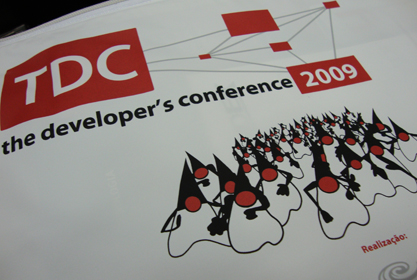Series: TDC Rio 2009 | Part 2 of 2 > Key insights from Brazil’s premier Java conference

On Wednesday at TDC Rio, one of the most anticipated talks was from Rod Johnson, the creator of the Spring Framework and author of some of the most influential Java books.
His session began at 10 a.m. and tackled the topic of change and trends in the Java ecosystem from the perspective of someone who helped shape it.
Cloud Computing: Distributed Power
Rod pointed to cloud computing as one of the major shifts redefining our relationship with infrastructure. The ability to distribute compute power on demand dramatically reduces the need for upfront hardware investment.
In simple terms: with the cloud, you pay for what you use — not for idle capacity.
Developers vs. Change-Averse Management
He joked (but not really) about the tension between developers eager to try new tech and managers who fear change. The result, according to Rod, is a kind of wall that stifles innovation just when it’s gaining traction.
The Monopolization Risk
Rod also raised concerns about monopoly in the Java ecosystem, warning that if a single company controls too much of the stack — from language to tools — innovation will suffer.
Referencing the then-recent acquisition of Sun by Oracle, he suggested a cautious approach: “Depending on one vendor for everything is dangerous.”
The Polyglot Revolution and the JVM’s Role
While other languages like Ruby, Scala, and Python were gaining popularity, Rod emphasized that Java remained the dominant language, and more importantly, that the JVM was the true asset.
“You can run Groovy, JRuby, Clojure — all on the same VM. That’s power.”
Open Source as an Innovation Engine
Rod credited open source as the reason Spring even existed. Without it, no small team could have competed with the likes of IBM, BEA, or Oracle to build a framework.
“Open source lowers the barrier to innovation.”
Still, he warned that too much fragmentation in the open source world can confuse developers — and stressed the need for good judgment when adopting libraries and frameworks.
Ruby on Rails and the Spring Roo Inspiration
Rod discussed how Ruby on Rails redefined developer productivity — not because it made code trivial, but because it emphasized rapid feedback and smart defaults.
Spring Source applied many of these lessons when creating Spring Roo, a lightweight tool to boost productivity without sacrificing clarity.
Spring Source, VMWare, and Open Source Direction
Some in the community feared that Spring Source’s acquisition by VMWare would affect its open source focus. But Rod reassured the audience that VMWare was aligned with the open source mission and would not change the community roadmap.
Cloud Foundry and the Future
Rod wrapped up by mentioning early efforts like Spring Source Cloud Foundry, which would later become a leader in Platform as a Service (PaaS) offerings. The aim: make deployment as simple as development.
Final Words: Brazil, It’s Your Moment
Rod closed with a message to Brazilian developers:
“Whether it’s lack of awareness or access, I don’t know — but this is your time. Open source is global, and it needs your voice.”
Posted shortly after Rod Johnson’s talk at TDC Rio 2009.
Series Navigation
- Previous: Part 1 - Mike Keith - Java EE 6: A Major Evolution
- Current: Part 2 - Rod Johnson on Java EE Trends and the Next 5 Years (Final)
- Complete series: TDC Rio 2009 Series